Un inusuale modello per le particelle elementari – Parte 1 (Parte 2)
An unusual elementary particle model – Part 1 (Part 2)
A nostro avviso, la più semplice struttura che occupa uno spazio ben definito, e composta esclusivamente da campi elettrici in rotazione, ha la forma di un anello dove il campo elettrico giace sulla generica sezione e il campo magnetico (ortogonale a quello elettrico) ha le linee di forza che sono distribuite attorno al foro. Le configurazioni qui mostrate sono soluzioni esatte delle equazioni di Maxwell. Pertanto tali strutture non portano né carica né pseudo-carica (divergenza nulla del campo elettrico ovunque).
In our opinion, the simplest structure that occupies a well-defined space, and made exclusively of rotating electric fields, has the shape of a ring where the electric field lies on the generic section and the magnetic field (orthogonal to the electric one) has lines of force that are distributed around the hole. The configurations shown here below are exact solutions of Maxwell’s equations. Therefore such structures carry neither charge nor pseudo-charge (zero divergence of the electric field everywhere).
 | Contour lines of the rotating electric field.  |
Si può aggiungere al campo elettrico una componente stazionaria radiale (positiva o negativa). In tal modo si ottengono configurazioni stabili che simulano in tutto e per tutto le caratteristiche dell’elettrone o del positrone. L’addizione della componente elettrica stazionaria è compatibile con la presenza di pseudo-massa il cui integrale esteso al volume dell’anello coincide con l’effettiva massa inerziale della particella. Va notato tuttavia che in questo caso bisogna ricorrere al nuovo insieme di equazioni che estendono quelle di Maxwell. La terna costituita da E (campo elettrico), B (campo magnetico), V (velocità di propagazione del segnale) ha una diversa orientazione a seconda che si abbia materia o antimateria. Si osservi che le due particelle non sono speculari, ma lo sono localmente le terne (E, B, V) che le compongono. Denoteremo con il colore rosso le particelle aventi carica elettrica negativa, mentre quelle verdi avranno carica elettrica positiva. D’ora in poi, per semplicità, riporteremo solo quello che accade sulla sezione degli anelli. Le figure si riferiscono a situazioni perfettamente circolari, ma nulla esclude che queste possano in realtà apparire leggermente deformate. L’anello stesso può essere grandemente deformato (mantenendo inalterata la sua topologia) senza che la carica e la massa totale si modifichino.
A radial stationary component (positive or negative) can be added to the electric field. In this way it is possible to obtain stable configurations that simulate in all respects the characteristics of the electron or positron. The addition of the stationary electrical component is compatible with the presence of pseudo-mass whose integral extended to the volume of the ring coincides with the effective inertial mass of the particle. It should be noted, however, that in this case we have to resort to the new set of equations which extend those of Maxwell. The triplet consisting of E (electric field), B (magnetic field), V (propagation speed of the signal) has a different orientation depending on whether there is matter or antimatter. Observe that the two particles are not specular, but are locally specular the triplets (E, B, V) that compose them. We will denote with the red color the particles having a negative electric charge, while the green ones will have a positive electric charge. From now on, for simplicity, we will report only what happens on the section of the rings. The figures refer to perfectly circular situations, but nothing excludes that these may actually appear slightly deformed. The ring itself can be greatly deformed (keeping its topology unchanged) without modifying the total charge and mass.
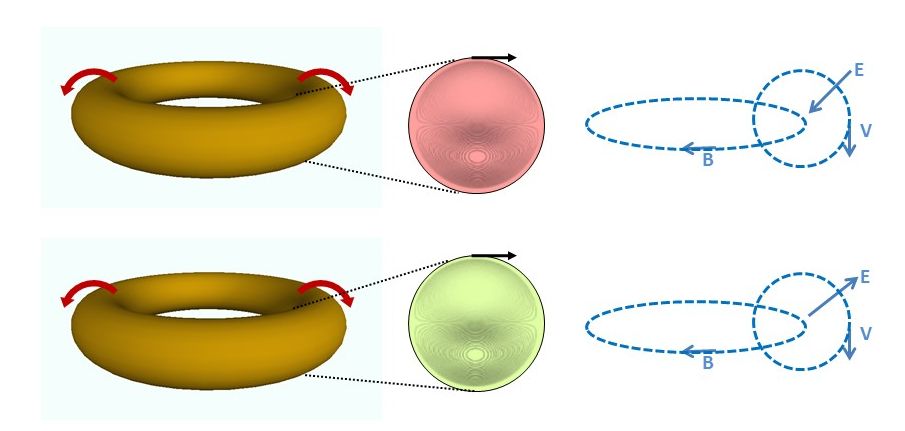
Gli anelli privi di carica si possono estendere, sempre nel rispetto delle equazioni di Maxwell, aggiungendo una sorta di guscio esterno. L’operazione può essere condotta in diversi modi a seconda della complessità che si vuole ottenere, combinando opportunamente diverse autofunzioni (in genere in numero di quattro). Nel caso qui sotto si possono vedere a sinistra un paio di autofunzioni stazionarie, le quali addizionate dinamicamente alla sezione ruotante dell’elettrone forniscono la figura a destra. I dettagli tecnici della costruzione si possono trovare negli articoli citati qua sotto.
The rings free of charge can be extended, always respecting Maxwell’s equations, by adding some sort of outer shell. The operation can be conducted in several ways according to the complexity to be obtained, suitably combining several eigenfunctions (generally four in number). In the case below you can see on the left a pair of stationary eigenfunctions, which, dynamically added to the rotating section of the electron, provide the figure on the right. The technical details of the construction can be found in the articles cited below.
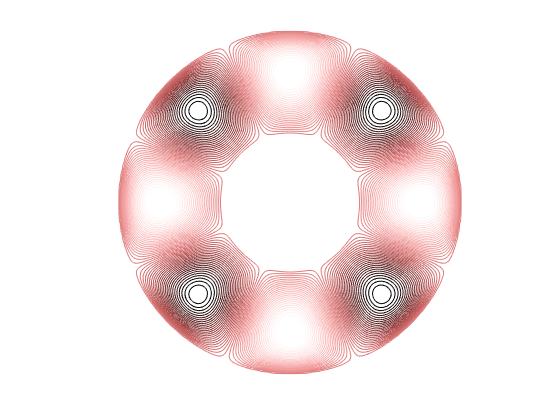 |  |  |
- C. Chinosi, L. Della Croce, D. Funaro, Rotating Electromagnetic Waves in Toroid-Shaped Regions, International Journal of Modern Physics C, Vol. 21, n. 1 (2010), pp. 11-32. DOI: 10.1142/S0129183110014926, arXiv:1002.1206v1
- D. Funaro, Trapping Electromagnetic Solitons in Cylinders, Mathematical Modelling and Analysis, Volume 1, Issue 19(2014). DOI10.3846/13926292.2014.892904, arXiv:1304.2287v1
- D. Funaro, Electromagnetic Waves in Annular Regions, Appl. Sci., Vol. 10, n.5 (2020), p. 1780, DOI: 10.3390/app10051780
- L. Fatone, D. Funaro, Electromagnetic Fields Simulating a Rotating Sphere and its Exterior with Implications to the Modeling of the Heliosphere, Math. Meth. Appl. Sci., 1-12 (2022), DOI: 10.1002/mma8621 , arXiv:2106.05851
Altri possibili gusci esterni sono disponibili. Si tenga sempre presente che l’intera struttura è un anello di cui queste sono sezioni, non necessariamente perfettamente circolari.
Other possible outer shells are available. Always keep in mind that the whole structure is a ring of which these are sections, not necessarily perfectly circular.
 |  |  |
Se, tramite l’addizione di componenti a divergenza non nulla, l’intero anello (elettrone più il suo guscio) esibisce una carica globale unitaria negativa, possiamo supporre di aver in tal modo ottenuto un muone. Tale particella decade, liberandosi del ricoprimento emettendo strutture alle quali possiamo dare il mome di neutrini. Questi ultimi si allontanano dal sito a velocità paragonabili a quella della luce, così come farebbe qualsiasi radiazione elettromagnetica libera. I neutrini portano pseudo-carica con media nulla e possono essere destrorsi o sinistrorsi. Nel loro viaggio (nella materia, ad esempio) possono interagire con scarsa probabilità con qualche nucleo, facendosi in questo modo rivelare da un qualche dispositivo di misura. I neutrini hanno anch’essi la forma di un anello e portano uno spin intrinseco, rettaggio di quando erano configurazioni rotanti facenti parte del muone. In maniera analoga, tramite un successivo guscio, si può pensare di costruire il tauone.
If, by adding components with non-zero divergence, the entire ring (electron plus its shell) exhibits a unitary negative global charge, we can assume that we have thus obtained a muon. This particle decays, getting rid of the covering by emitting structures to which we can give the name of neutrinos. The last move away from the site at speeds comparable to that of light, just as any free electromagnetic radiation would do. Neutrinos carry pseudo-charge with zero average and can be right-handed or left-handed. In their journey (inside matter, for example) they can interact with little probability with some nucleus, thus allowing themselves to be revealed by some measuring device. Neutrinos also have the shape of a ring and carry an intrinsic spin, a remind from when they were rotating configurations inside the muon. In an analogous way, through a subsequent shell, one could construct the tauon.
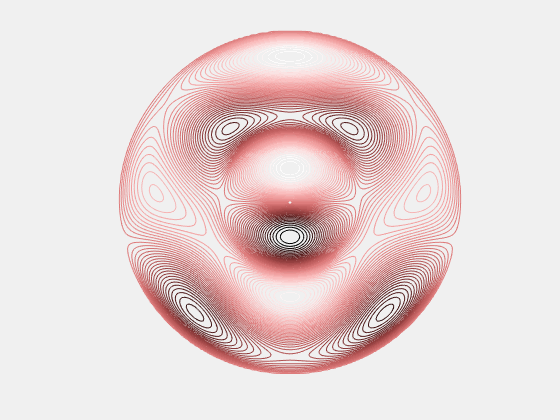
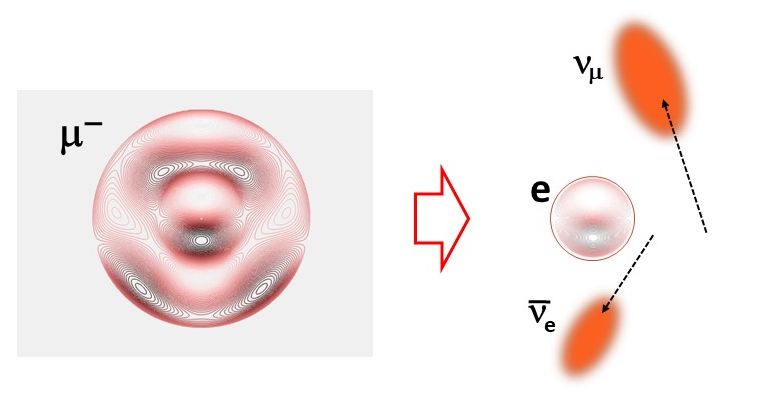
Con ingredienti simili si possono ricavare altri gusci e costruire ad esempio la seguente combinazione, la quale potrebbe simulare il comportamento di un pione. Nell’ambito della fluidodinamica i vortici ad anello possono, interagendo fra loro, trasformarsi in strutture dotate di una diversa dinamica pur mantenendo ciascuna sempre la forma toroidale. Si può pensare che il pione possa interagire con un neutrino, assorbirlo, e diventare un muone, il quale alla fine decade come si è accennato precedentemente. Tali argomentazioni sono ipotetiche, ma possono essere eventualmente verificate tramite simulazioni numeriche condotte sul modello differenziale. Tuttavia, al momento, una ricetta precisa non è disponibile. QUI si trova una carrellata qualitativa su come si possano ricavare modelli di particelle elementari a partire da costruzioni di questo genere.
With similar ingredients it is possible to obtain other shells and construct, for example, the following combination, which could simulate the behavior of a pion. In the context of fluid dynamics, vortex rings can, by interacting with each other, transform themselves into structures showing a different dynamic while always maintaining each of them the toroidal shape. We can assume that the pion interacts with a neutrino, absorbs it, and becomes a muon, which eventually decays as mentioned above. These arguments are hypothetical but can possibly be verified through numerical simulations implemented on the differential model. However, at the moment, a precise recipe is not available. HERE you can find a qualitative overview of how models of elementary particles can be obtained from constructions of this kind.
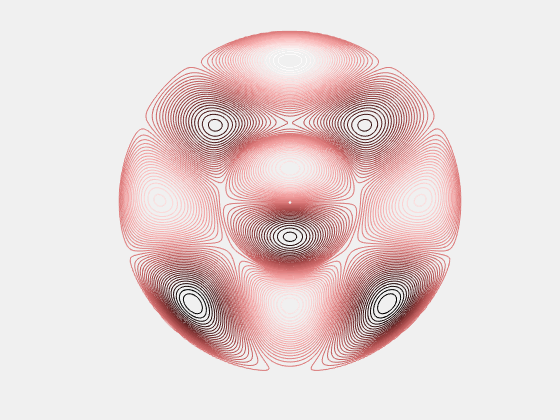
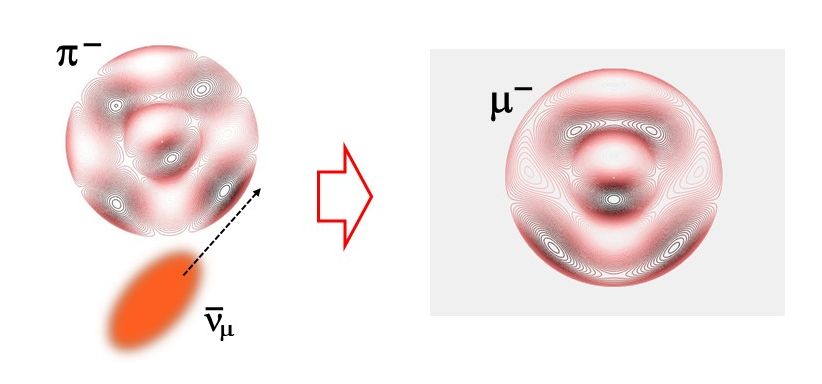
Per quanto riguarda il protone proponiamo le seguenti animazioni, dove il guscio esterno è rappresentato in buona approssimazione da una sfera, sebbene la topologia continui ad essere quella toroidale (vortice di Hill). Anche in questo caso si ricavano soluzioni esatte delle equazioni di Maxwell. Le geometrie complete sono ottenute ruotando gli spicchi attorno ad un asse. Le figure rappresentano l’intensità delle linee di forza del campo elettrico e nella raffigurazione tridimensionale mostrano l’evolversi di più anelli che si incastrano dinamicamente l’uno nell’altro. L’elettrone (rappresentato dal piccolo foro nelle prime due figure) continua ad essere di supporto all’intera struttura. Esso porta carica negativa ma è circondato da fotoni in rotazione ai quali può essere attribuita un’addizionale carica positiva. Si osservi che la carica totale non è ricavata dal bilancio di pesudo-cariche di diverso segno. E’ indotta invece dal fatto che l’intero oggetto rappresenta un buco non semplicemente connesso nell’intero spazio tridimensionale. Detto buco può essere in genere associato ad una carica unitaria negativa, positiva o nulla. In fin dei conti si sa che un protone è formato da due quarks di carica 2/3 e uno di carica -1/3. Tuttavia qui non ci sono quarks e non c’è neanche bisogno di introdurre i gluoni. I fotoni sono localizzati nell’anello, ma viaggiano a velocità paragonabili a quelle della luce. Non vi è dunque violazione del principio di indeterminazione. La configurazione non ha ancora ricevuto conferma sperimentale attraverso il modello differenziale, per cui non si sa se essa sia stabile e se la massa inerziale della particella corrisponda a quella effettiva del protone. Si hanno comunque favorevoli indizi che indicano che la proposta è ragionevolmente percorribile.
As far as the proton is concerned, we propose the following animations, where the outer shell is represented in good approximation by a sphere, although the topology continues to be the toroidal one (Hill’s vortex). Also in this case, exact solutions of Maxwell’s equations have been computed. The complete geometries are obtained by rotating the half slices around an axis. The figures represent the intensity of the lines of force of the electric field and in the three-dimensional representation they show the evolution of several rings that fit together dynamically (leapfrogging). The electron (represented by the tiny hole in the first two figures) continues to support the entire structure. It carries a negative charge but is surrounded by rotating photons to which an additional positive charge can be attributed. Note that the total charge is not obtained from the balance of pseudo-charges of different signs. Instead, it is induced by the fact that the whole object represents a non-simply-connected hole in the entire three-dimensional space. Said hole can generally be associated with a unitary negative, positive or zero charge. After all, we know that a proton is made up of two quarks of charge 2/3 and one of charge -1/3. However, there are no quarks here and there is not even need to introduce gluons. The photons are localized in the ring, but travel at speeds comparable to that of light. There is therefore no violation of the uncertainty principle. The configuration has not yet received experimental confirmation through the differential model, so it is not known whether it is stable and whether the inertial mass of the particle corresponds to the effective mass of the proton. However, there are favorable hints that indicate that the proposal is reasonably feasible.
 | 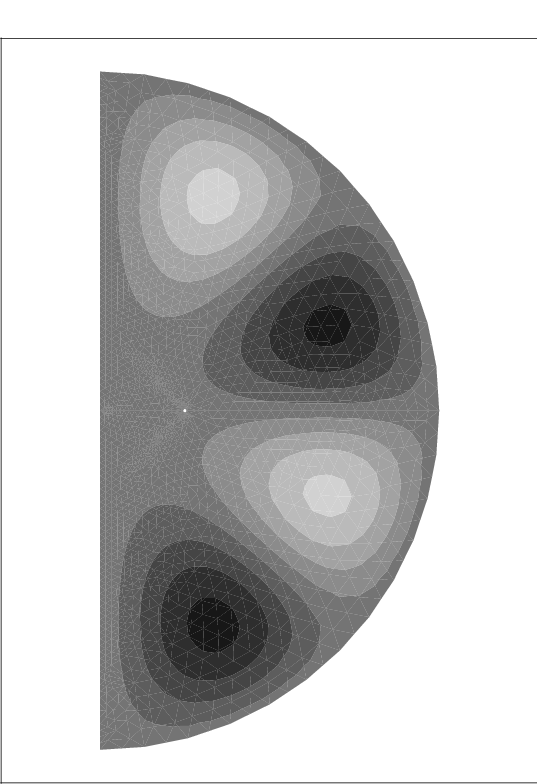 |  |
Due possibili armoniche vettoriali su tutta la sfera che producono un comportamento come quello sopra, sono date dalle seguenti sezioni. In tal caso è rappresentato il campo elettrico e non la sua intensità scalare, come nei casi precedentemente evidenziati.
Two possible vector harmonics on the whole sphere, that produce behavior like the one above, are given by the following sections. In this case the electric field is displayed and not its scalar intensity, as in the previously highlighted cases.
 | 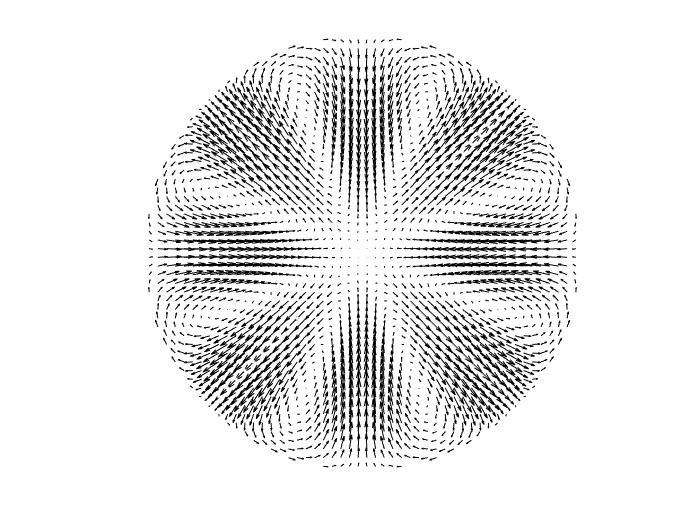 |